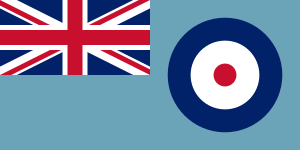Cardington Airfield
Cardington Airfield, previously RAF Cardington, is a former Royal Air Force station in Bedfordshire, England, with a long and varied history, particularly in relation to airships and balloons.
| Cardington Airfield | |
|---|---|
| Near Shortstown, Bedfordshire in England | |
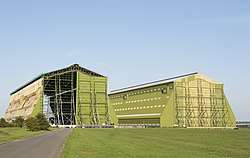 Former airship sheds at Cardington during 2013. | |
 Cardington Airfield Location within Bedfordshire | |
| Coordinates | 52°06′32″N 000°25′21″W |
| Type | Airfield |
| Height | 170 feet (52 m)[1] |
| Site information | |
| Owner | Ministry of Defence (MOD) |
| Condition | Closed |
| Site history | |
| Built | 1915 |
| In use | 1915–2000 |
| Fate |
|
| Airfield information | |
| Elevation | 30 metres (98 ft) AMSL |
Most of the former RAF station is in the parish of Eastcotts, as is the settlement of Shortstown.[2]
History
Birth under the Short brothers
The site started life as a private venture when aircraft manufacturing company Short Brothers bought land there to build airships for the Admiralty. It constructed a 700-foot-long (210 m) Airship hangar (the No. 1 Shed) in 1915 to enable it to build two rigid airships, the R-31 and the R-32. Short also built a housing estate, opposite the site, which it named Shortstown.
Royal Airship Works
The airships site was nationalised in April 1919, becoming known as the Royal Airship Works.
In preparation for the R101 project the No 1 shed was extended between October 1924 and March 1926; its roof was raised by 35 feet and its length increased to 812 feet. The No. 2 shed (Southern shed), which had originally been located at RNAS Pulham, Norfolk, was dismantled in 1928 and re-erected at Cardington.[3]
After the crash of the R101, in October 1930, all work stopped in Britain on airships. Cardington then became a storage station.
In 1936/1937 Cardington started building barrage balloons; and it became the No 1 RAF Balloon Training Unit responsible for the storage and training of balloon operators and drivers. In 1943 until 1967 it was home to the RAF Meteorological research balloons-training unit, undertaking development and storage[3] (after 1967 this was undertaken by the Royal Aircraft Establishment).
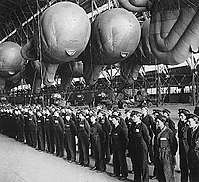 WAAF Barrage Balloon crews at RAF Cardington.
WAAF Barrage Balloon crews at RAF Cardington.
- Restored Fordson Sussex Balloon Winch Tender
- Rear view of Fordson Sussex on display at the RAF Museum Hendon.
 Balloons over London.
Balloons over London.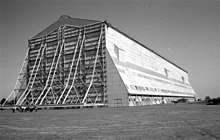 One of the two Cardington sheds with people in the foreground for scale.
One of the two Cardington sheds with people in the foreground for scale..jpg) Hangar 2 (the RNAS shed from Pulham, Norfolk)
Hangar 2 (the RNAS shed from Pulham, Norfolk)
Post airship use
The two airship sheds ceased being part of the RAF Cardington site in the late 1940s and they were put to other uses. The fence was moved, so they were outside the main RAF Cardington site.
In the 1950s, during the time of National Service, RAF Cardington was the reception unit, where thousands of recruits went to be issued with their kit.[4] The Parachute Regiment was stationed there as one of the hangars housed the balloons from which trainees made their first drops. In 1954 RAF Maintenance Command used Shed No.1 for its rehearsals for the Royal Tournament. The Royal Engineers also used Shed No.1 for its rehearsals for the 1987 Royal Tournament.
Hangar 1 was used by the Royal Aircraft Establishment (RAE) to operate balloons on behalf of the Met Office carrying instruments to measure conditions in the atmosphere. The balloons were also used in parachute development (although they were unmanned – using a heavy dead weight); much of this work was carried out in secret.
For both airships and barrage balloons, Cardington manufactured its own hydrogen, in the Gas Factory, using the steam reforming process. In 1948 the Gas Factory became 279 MU (Maintenance Unit), RAF Cardington; and then, in 1955, 217 MU.
217 MU, RAF Cardington, produced all the gases used by the Royal Air Force until its closure in April 2000; including gas cylinder filling and maintenance.
The following units were here at some point:[5]
- No. 1 Balloon Repair Depot
- No. 2 Aircraft Storage Unit
- No. 2 RAF Depot
- No. 2 Recruit Receiving Centre
- No. 4 Aviation Candidates Selection Board
- No. 7 Aviation Candidates Selection Board
- No. 9 Aviation Candidates Selection Board
- No. 14 Joint Services Trials Unit
- No. 19 Aviation Candidates Selection Board
- No. 25 Maintenance Unit RAF
- No. 26 Maintenance Unit RAF
- No. 102 'P' Balloon Flight
- No. 102 Personnel Dispersal Centre
- No. 104 'P' Balloon Flight
- No. 172 Personnel Transit Centre
- No. 217 Maintenance Unit RAF
- No. 244 Maintenance Unit RAF
- No. 260 (Balloon) Wing
- No. 912 (Balloon) Squadron
- No. 914 (Balloon) Squadron
- No. 924 (Balloon) Squadron
- No. 931 (Balloon) Squadron
- No. 954 (Balloon) Squadron
- No. 955 (Balloon) Squadron
- No. 956 (Balloon) Squadron
- No. 957 (Balloon) Squadron
- No. 958 (Balloon) Squadron
- No. 959 (Balloon) Squadron
- No. 963 (Balloon) Squadron
- No. 965 (Balloon) Squadron
- No. 967 (Balloon) Squadron
- No. 970 (Balloon) Squadron
- No. 971 (Balloon) Squadron
- No. 972 (Balloon) Squadron
- No. 973 (Balloon) Squadron
- No. 974 (Balloon) Squadron
- No. 975 (Balloon) Squadron
- No. 976 (Balloon) Squadron
- No. 986 (Balloon) Squadron
- No. 990 (Balloon) Squadron
- No. 1440 Flight RAF
- No. 2802 Squadron RAF Regiment
- Ferry Flight, Cardington
- Polish Balloon Unit
- Training Aids Development Flight RAF
Post military use
Driving Standards Agency (DSA)
The northern part of the site has for many years been used by the UK Government Driving Standards Agency Training and Development Centre to train Driving Examiners.[6]
Building Research Establishment
In 1971 Hangar 2 became the Fire Research Station (part of the Home Office) which conducted gas explosion experiments and for investigating fires. Full scale testing and fire research was undertaken from 1989.[3] In 1990 the facility was transferred to Building Research Establishment as a whole building test facility for the Cardington tests. Here, multi-storey steel, concrete and wooden buildings were constructed and then destructively tested within the huge space available. This shed was repainted and maintained in comparison with Shed 1.
The buildings tests were mentioned during the course of the BBC series The Conspiracy Files as evidence in the controversy surrounding the collapse of World Trade Center Building 7 on 11 September 2001.[7]
Meteorological Research Unit
The Met Office association with the site continues by maintaining a Meteorological Research Unit (MRU), this is responsible for conducting research into part of the atmosphere called the boundary layer by using a tethered balloon which is kept in a small portable hangar.[8]
Indoor Model Aircraft Flying
By the support of Lord Brabazon, fliers of extreme lightweight high-performance indoor flying models obtained access over a period of over 40 years. Four world championships were held in the 1970s and 1980s for teams from across Europe and the United States. Record flights were made of over 45 minutes under the highest available ceiling in the UK.
134 Air Training Corps
134 Sqn of the Air Training Corps has been based since 1953[9] within the former RAF Cardington site. As part of the redevelopment, a new Squadron headquarters has been built.[10]
Airships return to Cardington
A company called Airship Industries tried to revive the fortunes of the airship industry in the Shed 1 (on closure of the RAE operation) in the 1980s,[11] but the efforts ended in failure. As of 2016, the site was being used for the development of a hybrid airship, the Airlander 10, by the company Hybrid Air Vehicles.[12]
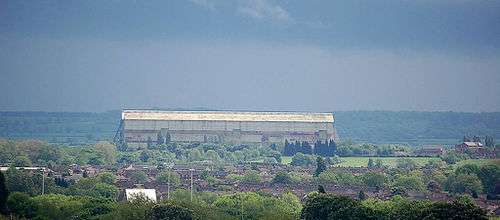
Media
In 1993 planning permission was granted for construction of theatrical stagings and the site was used for rehearsals by musicians including Paul McCartney Band on the Run: 25th Anniversary Edition, Spice Girls, U2, Rod Stewart, One Direction, Take That and AC/DC.[13]
In 1968 some scenes for Chitty Chitty Bang Bang were filmed at Cardington Sheds.[14] Also during the 1960s, much of the film Those Magnificent Men in Their Flying Machines was shot in the vicinity of the village. In 1971 the sheds appeared in the First World War war film Zeppelin starring Michael York.
The Star Wars film series has used both Sheds 1 and 2 for filming. Shed 1 was used to represent the Rebel base on Yavin 4 in the original 1977 film, and Shed 2 was later used itself for the Yavin base in the 2016 stand alone film Rogue One.[15][16]
Shed 2 has more recently been leased to Warner Bros. and is used as a studio for film and television productions. Director Christopher Nolan has used this location to film scenes for three of his movies; scenes from Batman Begins, The Dark Knight,[17] and Inception[18] were filmed in Shed 2. Christopher Nolan returned to this location during the summer of 2011 to film the plane scene for his third and final Batman film, The Dark Knight Rises.[19][20]
Parts of Curly's Airships, a concept album from 2000, about R101, by Judge Smith, were recorded in the sheds.[21]
The film Sky Captain and the World of Tomorrow was filmed at Cardington in 2004.[17]
Rihanna filmed parts of her music video for 'Shut up and drive' there.
In Series 14 Episode 3 of the motoring show Top Gear presenter James May used Cardington as the base for his 'Caravan Airship'.[22]
Three Warner Bros. films were shot in the sheds along with Warner Bros. Studios, Leavesden were: Pan, Fantastic Beasts and Where to Find Them and Justice League.
In popular culture
In the children's science fiction novel Sister Ships and Alastair by Dominic Green, the Cardington airship sheds are the visible front of a vast underground complex equipping spaceships of the fictional Royal Space Force with cobalt bombs.
One of the hangars is featured in the opening scene of the 2012 film The Dark Knight Rises.
New Cardington Development
Construction company Bellway Homes has bought most of the Cardington site and is building 1000 new homes on the site.[23]

.
Restoration of Hangar 1
English Heritage deemed Hangar Number 1 at Cardington to be at risk in 2007,[24] needing complete repair and refurbishment.[25] In October 2015 restoration of the hangars was completed and they were unveiled to the public.[26][27]
See also
References
- "The Royal Airship Works Shortstown". Bedford Borough Council. Archived from the original on 2 October 2016. Retrieved 22 July 2016.
- "Eastcotts Parish Boundaries" (PDF). Archived from the original (PDF) on 27 September 2007.
Parish map
- "134 Sqn Air Training Corps – History of Cardington Airship Sheds (website accessed: 28 July 2010)". 134.org.uk. 5 October 1930. Retrieved 16 May 2012.
- Personal experience. Recruits would collect their kit and take the oath before travelling by train to Bridgnorth for regulars or National Servicemen or Cosford for Boy Entrants
- "Cardington". Airfields of Britain Conservation Trust. Retrieved 20 April 2020.
- "DSA Training and Development Centre (website accessed: 28 July 2010)". Dsa.gov.uk. Retrieved 16 May 2012.
- "BBC Conspiracy Files". BBC News. 10 January 2010. Retrieved 16 May 2012.
- MET Office Boundary layer (website accessed: 08/01/13)
- "134 Sqn Air Training Corps – 134 Sqn History". 134.org.uk. Retrieved 16 May 2012.
- "134 Sqn Air Training Corps – New Sqn Headquarters – Build Progress". 134.org.uk. Retrieved 16 May 2012.
- "(website accessessed 28/07/10) "These delays lead to Airship Industries falling into receivership in September 1990"". Airships Online. 5 June 1987. Archived from the original on 15 April 2012. Retrieved 16 May 2012.
- Little, Reg (11 October 2007). "Airship could serve Oxford-Cambridge". Oxford Times. Archived from the original on 7 October 2008. Retrieved 5 March 2008.
- "Archived copy". Archived from the original on 20 November 2008. Retrieved 20 November 2008.CS1 maint: archived copy as title (link)
- "Chitty Chitty Bang Bang" (PDF). Archived from the original (PDF) on 28 September 2007. Retrieved 29 July 2010.
- "Cardington Sheds to make a Star Wars comeback". Bedfordshire on Sunday. 23 July 2015. Retrieved 22 December 2016.
- Lewis, Rebecca (20 December 2016). "11 things you may not have known about Rogue One: A Star Wars Story". Metro. Retrieved 22 December 2016.
- "Film Locations".
- "Inception to Film at the Airship Shed in Bedfordshire".
- Blass, Teddy (5 December 2010). "'The Dark Knight' Returns to the Cardington Airship Sheds". NolanFans.com. Retrieved 21 May 2011.
- Blass, Teddy (10 May 2011). "Production Update #1: Forts, and Wells, and IMAX! Oh My!". NolanFans.com. Retrieved 21 May 2011.
- "MergedFile - Curlys-Airships-Website.pdf" (PDF). www.judge-smith.com. Retrieved 20 June 2018.
- Caravan Airship, part 1/3 (Series 14, Episode 3) | Top Gear
- Bedfordshires Libraries – Shortstown Timeline (website accessed: 28/07/10) Archived 5 December 2008 at the Wayback Machine
- http://transportheritage.com/find-heritage-locations.html?sobi2Task=sobi2Details&sobi2Id=197
- "English Heritage – Heritage at risk register (website accessed: 28 July 2010)". Risk.english-heritage.org.uk. Archived from the original on 26 August 2011. Retrieved 16 May 2012.
- "Bedfordshire onsunday has closed".
- Airlander refurbishes iconic hangar ahead of 2016 takeoff
